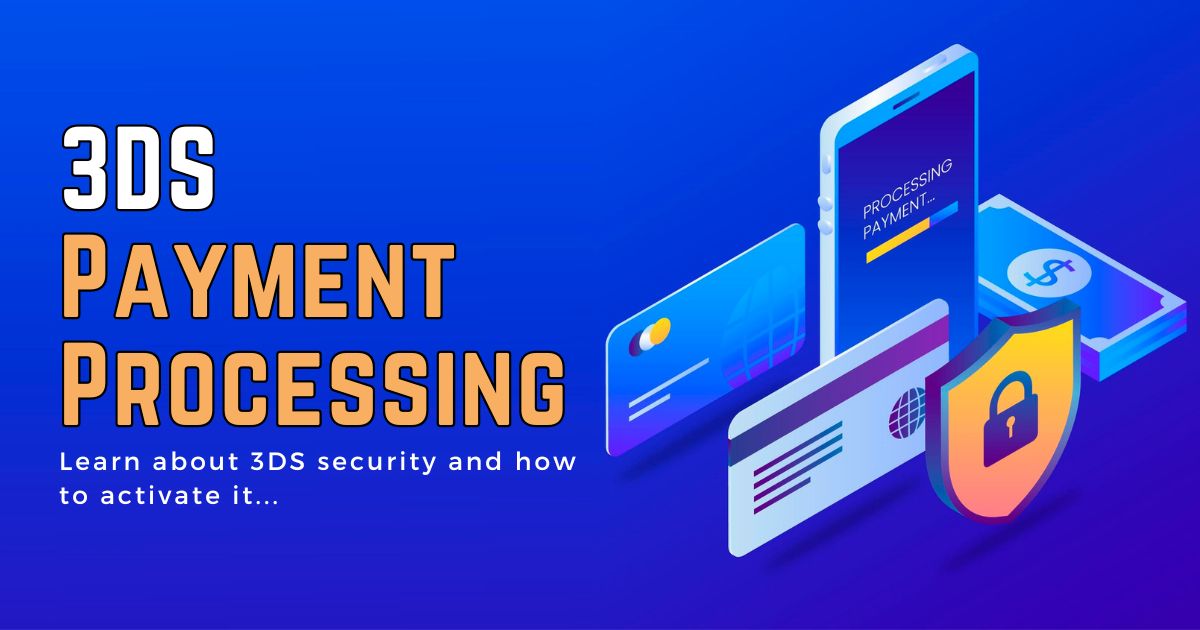
| June 6th, 2024 |
Comprehensive Guide to 3DS Payment Processing for Businesses!
Payment processing is an essential part of any firm that conducts transactions. It ensures that payments are securely and efficiently accepted, processed, and moved from the customer’s to the merchant’s accounts.
Payment Processing Terminals —
Payment processing terminals are equipment that enables the acceptance of payment cards (credit and debit). They read the card details and communicate with the payment processor to authorize and finalize the transaction. There are a variety of terminals available:
Traditional POS Terminals:
These are stationary devices commonly found in physical retail stores. They connect to a central system and often include a card reader, keypad, and receipt printer.
Mobile POS Terminals:
These are portable devices that connect via Bluetooth or Wi-Fi to a mobile device. They are ideal for businesses that require mobility, such as food trucks or pop-up shops.
Virtual Terminals:
These are software-based terminals that allow merchants to process payments online without a physical card reader. They are used for phone or mail orders.
Smart Terminals:
These advanced devices combine traditional payment processing with modern features such as touch screens, apps, and additional functionalities like inventory management.
Payment Processing Tools —
To streamline payment processing, businesses use a variety of tools, including:
Payment Gateways:
These are services that authorize and process online transactions. They act as intermediaries between the merchant and the payment processor.
Payment Processors:
These entities handle the transaction process, ensuring that funds are transferred from the customer’s bank to the merchant’s account.
Merchant Accounts:
These are specialized bank accounts that allow businesses to accept payments via credit and debit cards.
Point-of-Sale Systems (POS):
These integrated systems combine hardware and software to manage sales, inventory, and customer data, providing a seamless transaction experience.
Types of Payment Processing —
Payment processing can be classified into different types based on the method and medium of the transaction:
Credit Card Processing:
This involves handling transactions made using credit cards. It includes authorizing the transaction, checking for fraud, and ensuring funds are available.
Debit Card Processing:
Similar to credit card processing, funds are directly deducted from the customer’s bank account.
ACH Processing:
Automated Clearing House (ACH) processing involves transferring funds electronically between banks, commonly used for direct deposits and bill payments.
E-wallet Processing:
This involves transactions made through digital wallets like Apple Pay, Google Wallet, or PayPal, where customers store their card information securely.
Cryptocurrency Processing:
Accepting payments in cryptocurrencies like Bitcoin, which is becoming increasingly popular among tech-savvy customers.
Payment Processing Risks —
Despite the convenience, payment processing comes with its own set of risks, including:
- Fraud and Chargebacks: Unauthorized transactions can lead to chargebacks, where the customer disputes a charge, resulting in the reversal of the transaction.
- Data Breaches: Sensitive card information can be targeted by cybercriminals, leading to significant financial and reputational damage.
- Compliance Risks: Failure to comply with regulations like PCI DSS (Payment Card Industry Data Security Standard) can result in hefty fines.
- Operational Risks: Technical issues or outages in the payment processing system can disrupt business operations and result in lost sales.
What is 3DS in Payment Processing?
3DS (3-D Secure) is a security technique that aims to decrease fraud and add another degree of security to online credit and debit card transactions. It stands for “Three-Domain Secure,” and includes:
- Issuer Domain: The bank or entity that issued the card.
- Acquirer Domain: The merchant’s bank or payment processor.
- Interoperability Domain: The infrastructure that supports the 3DS protocol.
Benefits of 3DS:
- Enhanced Security: Adds an extra verification step, typically involving a password or biometric authentication, to ensure the cardholder is making the purchase.
- Reduced Fraud: Helps prevent unauthorized transactions, lowering the risk of chargebacks and fraud-related losses.
- Increased Customer Trust: Shoppers feel more secure, knowing their transactions are protected by additional verification steps.
How to Activate 3DS on Your Credit Card?
Activating 3DS on your credit card involves a few straightforward steps:
- Check with Your Bank: Contact your bank or card issuer to confirm that your card supports 3DS.
- Register for 3DS: If supported, the bank will guide you through the registration process, which may involve setting up a password or biometric verification.
- Activate During Purchase: Some banks automatically activate 3DS when you make an online purchase from a participating merchant. You may be prompted to verify your identity through a password, SMS code, or biometric method.
Key Considerations for Choosing a Payment Processing Service Provider:
| Key Consideration | Description |
|---|---|
| Understand Your Needs | Assess the volume of transactions, the types of payments you accept, and whether you need mobile, online, or in-store solutions. |
| Transaction Fees | Compare providers’ fees (e.g., per transaction, monthly, setup). Look for transparent pricing without hidden charges. |
| Security Features | Ensure the provider complies with PCI DSS and offers robust fraud prevention tools, including 3DS, tokenization, and encryption. |
| Integration | Check if the provider’s systems integrate seamlessly with your existing POS systems, e-commerce platforms, and accounting software. |
| Customer Support | Choose a provider with reliable customer service to assist with technical issues and disputes. |
| Reputation and Reviews | Research provider reviews and ratings to gauge reliability and customer satisfaction. |
| Scalability | Select a provider that can grow with your business, offering scalable solutions and additional features as needed. |
Conclusion —
Navigating the world of payment processing can be challenging, but understanding the many terminals, tools, types, and risks is critical for every organization. Businesses may ensure smooth, safe, and quick transactions by employing security standards such as 3DS and carefully selecting a payment processing service provider, resulting in increased customer satisfaction and growth.